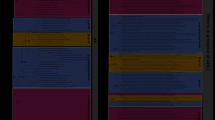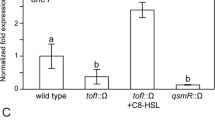Abstract
The plant pathogen Burkholderia glumae uses quorum sensing (QS) that allows bacteria to share information and alter gene expression on the basis of cell density. The wild-type strain of B. glumae produces quorum-sensing signals (autoinducers) to detect their community and upregulate QS-dependent genes across the population for performing social and group behaviors. The model organism B. glumae was selected to investigate adaptation, estimate evolutionary parameters, and test diverse evolutionary hypotheses by using experimental evolution. The wild-type B. glumae virulent strain showed genotypic changes during regular subculture due to oxygen limitation. The laboratory-evolved clones failed to produce the signaling molecule of C8-HSL/C6-HSL for activation of the quorum-sensing system. Further, the laboratory-evolved clones failed to produce catalase and oxalate for protecting themselves from the toxic environment at stationary phase and phytotoxins (toxoflavin) for infecting rice grain, respectively. The laboratory-evolved clones were completely sequenced and compared with the wild-type. Sequencing analysis of the evolved clones revealed that mutations in QS-responsible genes (iclR), sensor genes (shk, mcp), and signaling genes (luxR) were responsible for quorum-sensing activity failure. The experimental results and sequencing analysis revealed quorum-sensing process failure in the laboratory-evolved clones. In conclusion, the wild-type B. glumae strain was often exposed to oxidative stress during regular subculture and evolved as an avirulent strain (quorum-sensing mutant) by losing the phenotypic and genotypic characteristics.






Similar content being viewed by others
Change history
09 May 2020
Following the publication of this article [1], authors Jae Yun Lim and Ingyu Hwang have stated that they were not aware of, nor were they involved in the drafting, submission, or revision of this manuscript.
References
Waters CM, Bassler BL (2005) Quorum sensing: cell-to-cell communication in bacteria. Annu Rev Cell Dev Biol 21:319–346
Miller MB, Bassler BL (2001) Quorum sensing in bacteria. Annu Rev Microbiol 55:165–199
Von Bodman SB, Farrand SK (1995) Capsular polysaccharide biosynthesis and pathogenicity in Erwinia stewartii require induction by an N-acylhomoserine lactone autoinducer. J Bacteriol 177:5000–5008
Kim J, Kim JG, Kang Y, Jang JY, Jog GJ, Lim JY, Kim S, Suga H, Nagamatsu T, Hwang I (2004) Quorum sensing and the LysR-type transcriptional activator ToxR regulate toxoflavin biosynthesis and transport in Burkholderia glumae. Mol Microbiol 54:921–934
Diggle SP, Griffin AS, Campbell GS, West SA (2007) Cooperation and conflict in quorum-sensing bacterial populations. Nature 450:411
Jeong Y, Kim J, Kim S, Kang Y, Nagamatsu T, Hwang I (2003) Toxoflavin produced by Burkholderia glumae causing rice grain rot is responsible for inducing bacterial wilt in many field crops. Plant Dis 87:890–895
Latuasan H, Berends W (1961) On the origin of the toxicity of toxoflavin. Biochim Biophys Acta 52:502–508
Jang MS, Goo E, An JH, Kim J, Hwang I (2014) Quorum sensing controls flagellar morphogenesis in Burkholderia glumae. PLoS One 9:e84831
Hassett DJ, Alsabbagh E, Parvatiyar K, Howell ML, Wilmott RW, Ochsner UA (2000) A protease-resistant catalase, KatA, released upon cell lysis during stationary phase is essential for aerobic survival of a Pseudomonas aeruginosa oxyR mutant at low cell densities. J Bacteriol 182:4557–4563
Lumjiaktase P, Diggle SP, Loprasert S, Tungpradabkul S, Daykin M, Camara M, Williams P, Kunakorn M (2006) Quorum sensing regulates dpsA and the oxidative stress response in Burkholderia pseudomallei. Microbiology 152:3651–3659
Prescott L, Harley J, Klein D (2005) Microbiology, Sixth edition. Mcgraw-Hill, New York
Sreekrishna V (2006) Comprehensive biotechnology: including cell biology, genetics, microbiology and immunology. New Age International Pvt Ltd, India
Storz G, Imlayt JA (1999) Oxidative stress. Curr Opin Microbiol 2:188–194
Sambrook J, Fritsch EF, Maniatis T (1989) Molecular cloning. Cold spring harbor laboratory press, New York
Kim J, Kang Y, Choi O, Jeong Y, Jeong JE, Lim JY, Kim M, Moon JS, Suga H, Hwang I (2007) Regulation of polar flagellum genes is mediated by quorum sensing and FlhDC in Burkholderia glumae. Mol Microbiol 64:165–179
Goo E, Majerczyk CD, An JH, Chandler JR, Seo Y-S, Ham H, Lim JY, Kim H, Lee B, Jang MS (2012) Bacterial quorum sensing, cooperativity, and anticipation of stationary-phase stress. Proc Natl Acad Sci U S A 109:19775–19780
An JH, Goo E, Kim H, Seo Y-S, Hwang I (2014) Bacterial quorum sensing and metabolic slowing in a cooperative population. Proc Natl Acad Sci U S A 111:14912–14917
Lim J, Lee T-H, Nahm BH, Do Choi Y, Kim M, Hwang I (2009) Complete genome sequence of Burkholderia glumae BGR1. J Bacteriol 191:3758–3759
Iiyama K, Furuya N, Takanami Y, Matsuyama N (1995) A role of phytotoxin in virulence of Pseudomonas glumae Kurita et Tabei. Jpn J Phytopath 61:470–476
Levine A, Tenhaken R, Dixon R, Lamb C (1994) H2O2 from the oxidative burst orchestrates the plant hypersensitive disease resistance response. Cell 79:583–593
Farr SB, Kogoma T (1991) Oxidative stress responses in Escherichia coli and Salmonella typhimurium. Microbiol Rev 55:561–585
Imlay JA (2003) Pathways of oxidative damage. Annu Rev Microbiol 57:395–418
Lee J-S, Heo Y-J, Lee JK, Cho Y-H (2005) KatA, the major catalase, is critical for osmoprotection and virulence in Pseudomonas aeruginosa PA14. Infect Immun 73:4399–4403
Bandyopadhyay P, Byrne B, Chan Y, Swanson MS, Steinman HM (2003) Legionella pneumophila catalase-peroxidases are required for proper trafficking and growth in primary macrophages. Infect Immun 71:4526–4535
Piddington DL, Fang FC, Laessig T, Cooper AM, Orme IM, Buchmeier NA (2001) Cu, Zn superoxide dismutase of Mycobacterium tuberculosis contributes to survival in activated macrophages that are generating an oxidative burst. Infect Immun 69:4980–4987
Hasebe A, Iida S (2000) The novel insertion sequences IS1417, IS1418, and IS1419 from Burkholderia glumae and their strain distribution. Plasmid 44:44–53
Rojas A, Segura A, Guazzaroni ME, Terán W, Hurtado A, Gallegos MT, Ramos JL (2003) In vivo and in vitro evidence that TtgV is the specific regulator of the TtgGHI multidrug and solvent efflux pump of Pseudomonas putida. J Bacteriol 185:4755–4763
Guazzaroni M-E, Terán W, Zhang X, Gallegos M-T, Ramos JL (2004) TtgV bound to a complex operator site represses transcription of the promoter for the multidrug and solvent extrusion TtgGHI pump. J Bacteriol 186:2921–2927
Gerischer U, Segura A, Ornston LN (1998) PcaU, a transcriptional activator of genes for protocatechuate utilization in Acinetobacter. J Bacteriol 180:1512–1524
Yamamoto K, Ishihama A (2003) Two different modes of transcription repression of the Escherichia coli acetate operon by IclR. Mol Microbiol 47:183–194
Lu Y, Rashidul IM, Hirata H, Tsuyumu S (2011) KdgR, an IClR family transcriptional regulator, inhibits virulence mainly by repression of hrp genes in Xanthomonas oryzae pv. oryzae. J Bacteriol 193:6674–6682
Jiang H, Kendrick KE (2000) Characterization of ssfR andssgA, two genes involved in sporulation of Streptomyces griseus. J Bacteriol 182:5521–5529
Krell T, Lacal J, Busch A, Silva-Jiménez H, Guazzaroni M-E, Ramos JL (2010) Bacterial sensor kinases: diversity in the recognition of environmental signals. Annu Rev Microbiol 64:539–559
Hisanaga Y, Ago H, Nakagawa N, Hamada K, Ida K, Yamamoto M, Hori T, Arii Y, Sugahara M, Kuramitsu S (2004) Structural basis of the substrate-specific two-step catalysis of long chain fatty acyl-CoA synthetase dimer. J Biol Chem 279:31717–31726
Gallegos M-T, Schleif R, Bairoch A, Hofmann K, Ramos JL (1997) Arac/XylS family of transcriptional regulators. Microbiol Mol Biol Rev 61:393–410
Martínez-Bueno M, Molina-Henares AJ, Pareja E, Ramos JL, Tobes R (2004) BacTregulators: a database of transcriptional regulators in bacteria and archaea. Bioinformatics 20:2787–2791
Schell MA (1993) Molecular biology of the LysR family of transcriptional regulators. Annu Rev Microbiol 47:597–626
Acknowledgements
Sequencing services were provided by the National Instrumentation Center for Environmental Management (NICEM). The authors would like to thank the members of Agricultural Biotechnology for their support. GG gratefully acknowledges JaeKyung Chon (NICEM) and Eunhye Goo for their helpful discussions.
Funding
This work was supported by the Creative Research Initiatives Program of the National Research Foundation of Korea (Grant 2010-0018280).
Author information
Authors and Affiliations
Contributions
IH conceived and directed the study of the evolution experiment. GG performed all experiments, drafted the manuscript and prepared tables and figures. JYL performed genome analyses and prepared Figures. GG, JYL, and IH discussed, analyzed data and revised the manuscript.
Corresponding author
Ethics declarations
Conflict of Interest
The authors declare no conflict of interest.
Electronic supplementary material
ESM 1
(DOCX 723 kb)
Rights and permissions
About this article
Cite this article
Gnanasekaran, G., Lim, J.Y. & Hwang, I. Disappearance of Quorum Sensing in Burkholderia glumae During Experimental Evolution. Microb Ecol 79, 947–959 (2020). https://doi.org/10.1007/s00248-019-01445-0
Received:
Accepted:
Published:
Issue Date:
DOI: https://doi.org/10.1007/s00248-019-01445-0




